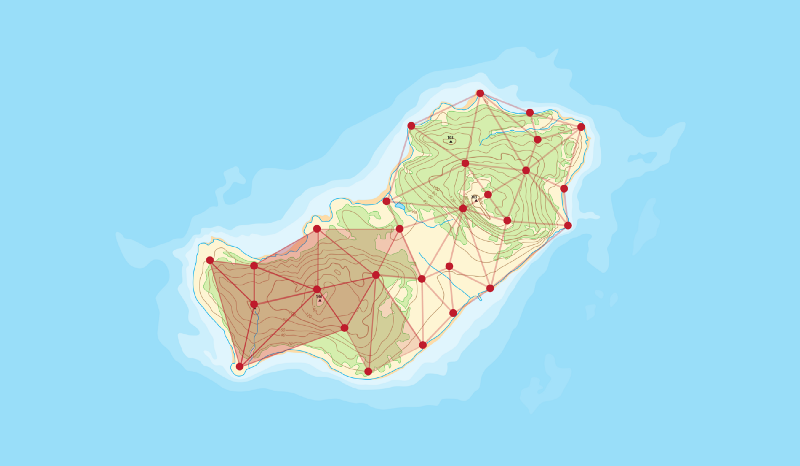Energy, Sensors, and Triangulation
The explorer’s metaphor is a series of articles that aim to provide an introduction to sensemaking and complexity management for designers, managers, and decision-makers. Read here part 1, part 2, and part 3.

Explorers should not be seen as lonely individuals. As part of a larger system, they are components of the network that represent their organisation, and distribution is a necessary feature of the network.
Not everyone in an organization has knowledge of or is aware of the same things, at the same time, in the same way. This is not (necessarily) a matter of hierarchy: consider instead how formal and informal networks work and influence the flow of information.
Like an island might possess beaches, forests, rivers, mountains, abrupt cliffs, (etc.) organisations’ complexity, activities, and processes are both informed by the larger context of the organisation itself as well as the local specificities that people are facing.
Information as energy ⚡️
Seeing information as energy allows one to treats it with similar properties. Energy cannot be created nor deleted, only transformed. More so, energy can move through mediums (energy vectors), which are not all equal in terms of effectiveness & efficiency.
Formal and informal ways to gather and/or treat information constrain information in different ways, offering different losses & gains on the net output, affecting scope and scale of understanding.
For instance, an undirected, unbonded conversation is an informal way to gather information communicating a lot of depth & details, allowing context-blending (people can relate to similar personal experiences) and providing flexible enabling constraints through stories. The downside might be added noise in the information processing.
On the other side of the spectrum, directed, motivated, goal-oriented methods like, say, a survey or some forms of interviews formalise information through predetermined/anticipated inputs, filtering information and providing more rigid constraints.
There is a relationship between how we are making sense of our context and what we can do about this understanding.

The human sensor network
As human beings, we rely on our senses to understand the world (at a personal level). Our senses are distributed over all the body. They help us triangulate very well distances, speed, sizes, danger, (etc.) of objects and events through a variety of input types: sight, hearing, touch, etc. They enable us to make sense, perceive, anticipate, act, and influence our environment.
Embodied cognition relates to the concept that body and mind are inseparable and that they are both necessary features of our cognitive abilities. In other words, we cannot “think” how we think and “experience the world” how we experience it — aka be human — without the brain AND the body (and its senses) we have. Cognition is, therefore, distributed, not located [1].
“This is not [the] claim that we need a body to reason; rather, it is the striking claim that the very structure of reason itself comes from the details of our embodiment…” — George Lakoff and Rafeal Núñez
Our senses are a network of sensors through which we perceive the world.
Similarly, explorers can build a sensory network at a challenge and/or organizational level, by connecting parts & people to help give shape to the island’s or archipelago’s landscape & topography. Doing so help triangulate information and give depth in terms of meaning & understanding, creating a new “meta-sense of self” for the organisation.
Building such a network can be done through various means and mediums, but it is worth mentioning they will not all allow for the same type of interactions impacting the type of information that can be gathered, the effectiveness of the overall network response, and our perception of the information.
- Synchronicity allows for immediate, direct, prompted feedback which tends to be also very localised and context-specific. It is extremely useful contextually but also energy-intensive and, therefore, generally hard to sustain for a long period of time.
- Asynchronicity allows for delayed, indirect, unprompted feedback. More energy-effective but also less context-specific, it can be run over long periods of time. This tends to allow to build a much broader sense of the patterns at play.
- Availability (perceived instantaneity) will define the effort (friction) that the network will have to take in order to generate feedback. The more asynchronous, the greater we want perceived instantaneity because of delayed response from the feedback mechanism.

All are needed at some points. Time and speed variations are important elements and patterns of synchronicity, asynchronicity, and availability are interesting ways to capture, process, and triangulate information from the network, by the network.
Thanks for reading!
This is part four of a series of articles that aim to provide an introduction to sensemaking and complexity management for designers, changemakers, managers, and decision-makers through metaphors & abstractions.
Special thanks to Marc Baumgartner, Cameron Norman, Enrique Martínez, Daiana Zavate, Lucien Langton, Corina Lupu, Alexis Gerome, and the Design & Critical Thinking Community for their help in improving this article and sharing thoughts & ideas.













Discussion